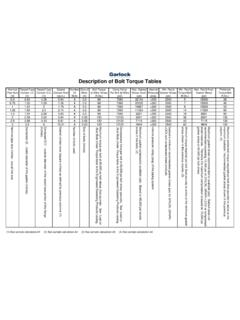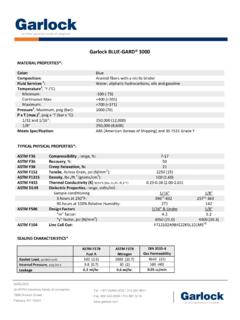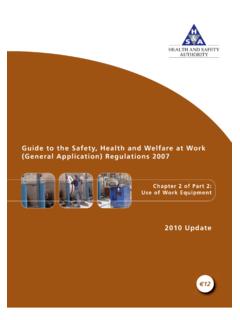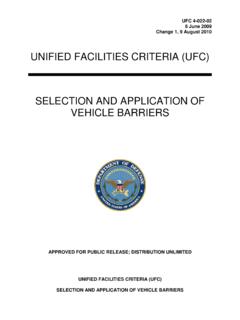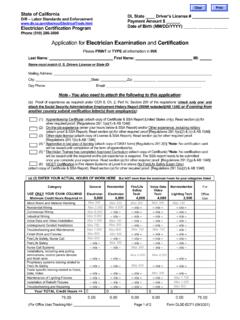Transcription of TO: General Distribution FROM: Applications Engr.
1 TO: General Distribution FROM: Applications Engr. RE: Gasket Thickness DATE: May 15, 2008. The question of proper gasket thickness for a particular application is one which comes up frequently but is difficult to answer simply. As such, we encourage customers to discuss thickness selection with Applications Engineering whenever there is uncertainty in the right selection . It is hoped that this document will at least help explain why this issue can be tricky, and point out some possible problems before they occur. As a gasketing manufacturer, Garlock recommends the use of thinner gaskets wherever possible . More on that below. We should start by saying that there are some situations where a thicker gasket is needed and recommended. Some common Applications where 1/8 is necessary and acceptable: Thin flanges that will not be flat when bolted, such as thick angle iron or plate steel.
2 Large diameter flanges like AWWA water line flanges, 10 foot diameter vessels. Many full face large diameter flanges built for low internal pressure with limited bolting. Older flanges that may be pitted, warped or damaged in some way. One reason that thicker gaskets are used in low pressure large diameter flanges is that these flanges are not built with a lot of bolting; there is no high internal pressure so the design does not need a great deal of bolting. Limited bolting will mean there will be limited (low) compression of the gasket, and thin flanges mean they will distort when bolted, creating little or no compression in the spaces between bolts. Thin gaskets simply will not have enough compression available to handle these less than flat flanges. This seems to run a bit contrary to our normal thinking.
3 If you look at our recommended installation stresses, we ask for more stress (higher loads) on the gasket as the thickness increases. But where the loads are very low, as in angle iron flanges, the flange will rarely be thick enough to stay flat and seal a thin gasket. In most cases, the internal pressure on these flanges is low, so there is not a high risk of blow-out of the thicker gasket. An example would be a recent call for 66 flanges, approximately thick, using (20) 5/8 . bolts. That is an incredibly low number of small bolts for such a large flange. The service was oil at NO PRESSURE. The customer asked about 1/16 MULTISWELL ; the better choice would be 1/8 , for two reasons. The bolt spacing is so large that there will be very little compressive load in between bolts.
4 Thin gaskets do not conform well to bowed flanges. 1666 Division Street Palmyra, New York 14522 USA 1-315-597-4811 Toll Free:1-800-448-6688 Fax:1-315-597-3216 An EnPro Industries Company Debtor in Posession There is no down side or disadvantage to using thicker gaskets where there is no internal pressure, because the gasket is not going to blow out. The situation is much different in flanges that are designed for higher pressures. Those flanges have a great deal more thickness to them, which means they can typically remain flat, when bolted, to a few thousands of an inch. THESE situations are where the Thinner is Better . advice is pertinent. The advantages of thin gaskets are many: 1. Higher blow-out resistance due to the smaller surface areas exposed to the internal pressure.
5 2. Lower leak rates due, again, to the smaller surface areas. 3. Better torque retention in the fasteners, due to the lower creep relaxation characteristics of thinner gaskets. 4. Lower cost of the gasket itself. Thinner is better wherever possible , and that is the difficult part of the statement to define. It is not always possible to use thin gaskets. Thicker gaskets will conform better to badly damaged or warped flanges. This is because a gasket's ability to fill in flange irregularities is based on the amount the gasket compresses at a given load. Since compressibility at a particular load is expressed as a percentage of the gasket's original thickness, a thicker gasket with a larger original thickness will actually compress a larger distance. 10% compression of a.
6 063 gasket means a compression of .0063 , or just over 6 mil. If we obtain 10% compression of a .125 . gasket, we will compress the gasket over 12 mil. This extra gasket compression means the thicker gasket will be able to fill-in deep scratches or low spots better than a thinner gasket. The apparent advantages of using a thicker gasket can be misleading, however. While the thicker gasket will seal more flange irregularities, it can lead to more problems down the road. The higher creep relaxation will mean the end-user may need to retorque the fasteners to maintain adequate compressive load on the gasket over the life of the joint. This situation is compounded by the increased surface area of the gasket exposed to the internal pressure, which actually creates higher total forces trying to push the gasket out of the joint.
7 (The internal pressure is measured in psi, or pounds per square inch . Thicker gaskets appear as taller . surfaces to the pressure, which means a larger surface area. Pounds per square inch multiplied by greater square inches yields greater pounds of force.). Lastly, since all gasket materials are permeable to some degree, media can pass through the body of the gasket. Thicker gaskets create a larger path for permeation to occur, and therefore higher leak rates. It should be noted here that the reverse can also occur. If a gasket is too thin to conform to flange irregularities, the media can leak over instead of through the gasket, and the leak rate could be higher than with the thicker gasket. Flanges which require use of thicker gaskets create problems over which a gasket manufacturer has no control.
8 The best solution is to use or design flanges with higher compressive loads available, keep the finish in good condition, and use 1/16 or even 1/32 thick gaskets. End- users who are designing flanges for non-asbestos sheet should consider using the higher M &. Y factors for 1/8 in their design calculations but install 1/16 thick gasketing. These suggestions would eliminate some of the most frequent causes of joint failure. _____. 1666 1666 Division Street Palmyra, New York 14522 USA 1-315-597-4811 Toll Free: 1-800-448-6688 Fax: 1-315-597-3216 An EnPro Industries Company Special situations where very specific thickness is needed. There are many gasketed joints where a specific gasket thickness is needed, and for many of these, it's important to remember that it is the FINAL COMPRESSED THICKNESS that must be considered.
9 These may include the following examples: Split case pumps: The final thickness is critical because it affects the clearances between the two halves of the pump. These most often use a 1/64 CNA (Compressed non- asbestos) gasket. Customers sometimes ask for a sheet with close tolerance thickness, with a smaller thickness variation. It is important to remember that a more compressible gasket cannot usually be substituted here, as the FINAL thickness will be different. Piping systems with long runs that were set up for a particular gasket thickness. A. standard spiral wound gasket, for example, will measure 1/8 thick when compressed. There may be spacing issues on a long run of pipe, if a thinner gasket is used, if there are numerous joints in a line, as there will be a gap at the end of the run.
10 Gaskets in grooves: Where a tongue and groove arrangement is used, or grooved flange to flat, the gasket must fill the space, WHEN COMPRESSED, before the flanges hit metal to metal. The compressed thickness after loading must be calculated, and that must be greater than the gap created when the flanges hit. For example, if the groove is . deep, and the tongue is deep, the gasket's compressed thickness must be greater than . Otherwise, the flanges will hit before the gasket is properly compressed. In one case, the customer substitutes GYLON Style 3545 where Style 3510 was specified, and the 3545 was never fully compressed and leaked, because it needed to be compressed to approximately 1/3rd of its original thickness. The type of gasketing material and the compressive load available will also affect the thickness required to seal a particular joint.



